
The ancient Egyptians had many advanced scientific technologies, with much being found in picture form and in three-dimensional models throughout Egypt. Themes reflecting scientific knowledge and achievement can be found throughout the world in various ancient civilizations. These teachings seemed to center on electromagnetic energies.
Scenes depict scientists of that timeline able to work in fields of alchemy, biology, chemistry, dentistry, anesthesiology, air flight, and the electromagnetic energies of the Great Pyramid among other sacred sites - how that link together and to the sacred geometry that forms our universe. Much of the interpretation is left to those in our timeline to decipher.

Rare squared form of tet, at left. The heavy animal may be a ancient symbol for heavy electrons; the squaring may be an ancient way of referring to water. The tet might employ magneto hydrodynamic principles like ancient Egyptian and modern transportation technology, but it may employ it in obtaining energy from certain materials as well.
The study of science and medicine were closely linked to religion as seen in many of the ancient rituals. The "pouring" and "anointing" we see in so many Egyptian works is the application of electromagnetic forces and not the application of actual fluids. Much of this was linked with 'magic' of some sort - as many unexplained things did occur. These were often considered miracles.
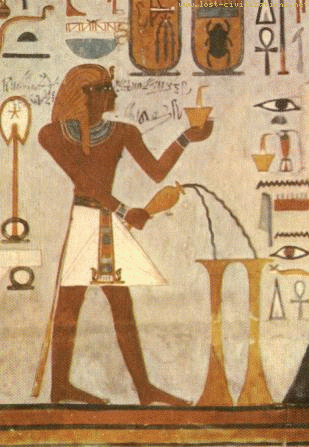
This image implies that something poured into the planet could cause spontaneous growth. The "pouring of water or an offering" and the outlandish angles at which it is being done tends to make it one of countless scenes reinforcing the idea that such scenes are instead showing the migration or transmission of electromagnetic forces. Every sacred symbol - linked to the gods - had a scientific as well as an esoteric purpose.

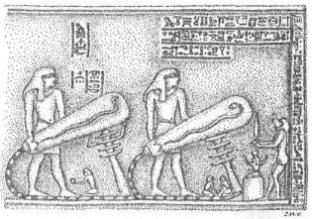

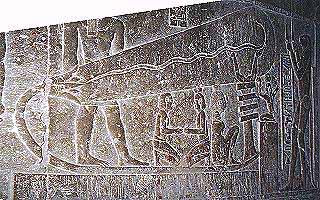

The cathode-ray tube or "Crookes' tube" like object depicted in scenes from the temple of Hathor at Dendera may depict a relativistic source of these heavy electrons - which could drastically expedite the magical processes which involve these particular tubes.
The walls are decorated with human figures next to bulb-like objects reminiscent of oversized light bulbs. Inside these "bulbs" there are snakes in wavy lines. The snakes' pointed tails issue from a lotus flower, which, without much imagination, can be interpreted as the socket of the bulb. Something similar to a wire leads to a small box on which the air god is kneeling. Adjacent to it stands a two-armed djed pillar as a symbol of power, which is connected to the snake. Also remarkable is the baboon-like demon holding two knives in his hands, which are interpreted as a protective and defensive power.
In his book The Eyes of the Sphinx, Erich Von Däniken writes that the relief is found in "a secret crypt" that "can be accessed only through a small opening. The room has a low ceiling. The air is stale and laced with the smell of dried urine from the guards who occasionally use it as a urinal." The room is not so secret, however, as many tourists visit and photograph the room every year. Von Daniken sees the snake as a filament, the djed pillar as an insulator, and claims "the monkey with the sharpened knives symbolizes the danger that awaits those who do not understand the device." This "device" is, the reader is assured, an ancient electric light bulb.

Metallurgy in particular was carried on with an elaborate technique and a business organization not unworthy of the modern world, while the systematic exploitation of mines was an important industry employing many thousands of workers. Even as early as 3400 B.C., at the beginning of the historical period, the Egyptians had an intimate knowledge of copper ores and of processes of extracting the metal. During the fourth and subsequent dynasties (i.e. from about 2900 B.C. onwards), metals seem to have been entirely monopolies of the Court, the management of the mines and quarries being entrusted to the highest officials and sometimes even to the sons of the Pharaoh.
Whether these exalted personages were themselves professional metallurgists we do not know, but we may at least surmise that the details of metallurgical practice, being of extreme importance to the Crown, were carefully guarded from the vulgar. And when we remember the close association between the Egyptian royal family and the priestly class we appreciate the probable truth of the tradition that chemistry first came to light in the laboratories of Egyptian priests.
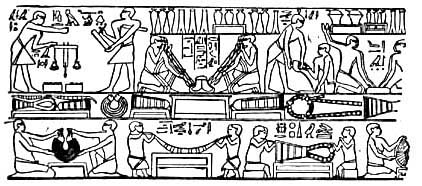
Metal-Workers' Workshop in Old Egypt
Copper and Iron Extraction
In addition to copper, which was mined in the eastern desert between the Nile and the Red Sea, iron was known in Egypt from a very early period and came into general use about 800 B.C. According to Lucas, iron appears to have been an Asiatic discovery. It was certainly known in Asia Minor about I300 B.C. One of the Kings of the Hittites sent Rameses II, the celebrated Pharaoh of the Nineteenth Dynasty, an iron sword and a promise of a shipment of the same metal.
The Egyptians called iron 'the metal of heaven' or ba-en-pet, which indicates that the first specimen employed were of meteoric origin; the Babylonian name having the same meaning.
It was no doubt on account of its rarity that iron was prized so highly by the early Egyptians, while its celestial source would have its fascination. Strange to say, it was not used for decorative, religious or symbolical purposes, which - coupled with the fact that it rusts so readily - may explain why comparatively few iron objects of early dynastic age have been discovered.
One which has fortunately survived presents several points of interest: it is an iron tool from the masonry of the Great Pyramid of Khufu at Giza, and thus presumably dates from the time when the Pyramid was being built, i.e. about 2900 B.C. This tool was subjected to chemical analysis and was found to contain combined carbon, which suggests that it may have been composed of steel.
By 666 B.C. the process of casehardening was in use for the edges of iron tools, but the story that the Egyptians had some secret means of hardening copper and bronze that has since been lost is probably without foundation. Desch has shown that a hammered bronze, containing 10.34 per cent of tin, is considerably harder than copper and keeps a cutting edge much better.
Of the other non-precious metals, tin was used in the manufacture of bronze, and cobalt has been detected as a coloring agent in certain specimens of glass and glaze. Neither metal occurs naturally in Egypt, and it seems probable that supplies of ore were imported from Persia.
Lead, though it never found extensive application, was among the earliest metals known, specimen having been found in graves of pre-dynastic times. Galena (PbS) was mined in Egypt at Gebel Rasas ('Mountain of Lead'), a few miles from the Red Sea coast, and the supply must have been fairly good, for when the district was re-worked from 19I2 to 1915 it produced more than I8,000 tons of ore.
Gold
The vast quantities of gold amassed by the Pharaohs were the envy of contemporary and later sovereigns. Though much was imported, received by way of tribute, or captured in warfare, the Egyptian mines themselves were reasonably productive.
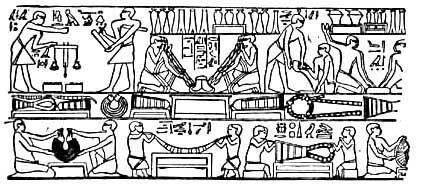
Egyptian Goldsmiths Washing, Melting and Weighing Gold Beni Hasan, 1900 B.C.
Over one hundred ancient gold workings have been discovered in Egypt and the Sudan, though within the limits of Egypt proper there appear to have been gold mines only in the desert valleys to the east of the Nile near Ikoptos, Ombos and Apollinopolis Magna.
Of one of these mines - possibly near Apollinopolis - a plan has been found in a papyrus of the fourteenth century B.C., and the remains of no fewer than 1,300 houses for gold-miners are still to be seen in the Wadi Fawakhir, halfway between Koptos and the Red Sea. In one of the treasure chambers of the temple of Rameses III, at Medinet-Habu, are represented eight large bags, seven of which contained gold and bear the following descriptive labels.
The Egyptian word for gold is nub, which survives in the name Nubia, a country that provided a great deal of the precious metal in ancient days. French Scientist Champollion regarded it as a kind of crucible, while Rossellini and Lepsius preferred to see in it a bag or cloth, with hanging ends, in which the grains of gold were washed - the radiating lines representing the streams of water that ran through.
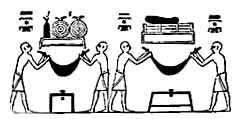
Gold Washing in Ancient Egypt
Crivelli has more recently advanced the theory that the gold symbol is the conventional sign for a portable furnace used for the fusion of gold, and that the rays represent the flames, which, 'as can be observed in the use of this type of furnace, are unable to ascend because the wind inclines them horizontally'.
In the later dynasties, the Egyptians themselves forgot the original significance of the sign and drew it as a necklace with pendent beads. Elliot Smith however says that this was the primitive form and became the determinative of Hathor, the Egyptian Aphrodite, who was the guardian of the Eastern valleys where gold was found.
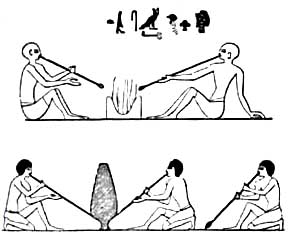
Egyptian Goldsmith Workshop in the Pyramid Age
The gold mines in Nubia and other parts of the Egyptian empire seem to have been very efficiently designed and controlled, though with a callous disregard for the human element employed.
Alluvial auriferous sand was also treated, a distinction being made between the gold obtained in this way and that extracted from the mines. The latter was called nub-en-set, i.e. gold of the mountain, while alluvial gold was named nub-en-mu, i.e. 'gold of the river'. Auriferous sand was placed in a bag made of a fleece with the woolly side inwards; water was then added and the bag vigorously shaken by two men. When the water was poured off, the earthy particles were carried away, leaving the heavier particles of gold adhering to the fleece. There is a picture of this operation on one of the buildings at Thebes.
Mercury
Mercury (Greek-hydra gyros, liquid silver; latin-argentum vivum, live or quick silver) is stated to have been found in Egyptian tombs of from 1500-1600 B.C.
Metal and Mysticism
In the early centuries of our era, however, there gradually developed a mysticism among chemical writers due to Egyptian and Chaldean religious magical ideas, and there developed a fanciful relation of the metals as such to the sun and the planets, and as a consequence there arose the belief that it was necessary to confine the number of metals to seven.
Thus Olympidorous-in the 6th century of our era gives the following relation:
Gold - The Sun
Silver - The Moon
Electrum - Jupiter Iron - Mars
Copper - Venus
Tin - Mercury
Lead - Saturn
Metallurgy was by no means the only art practiced with conspicuous success by the ancient Egyptian craftsmen. Glass was almost certainly the invention, not of the Phoenicians, but of the Egyptians, and was produced on a large scale from a very early date.

This art is of very ancient origin with the Egyptians, as is evident from the glass jars, figures and ornaments discovered in the tombs. The paintings on the tombs have been interpreted as descriptive of the process of glass blowing. These illustrations representing smiths blowing their fires by means of reeds tipped with clay. Therefore it can be concluded that glass blowing is apparently of Egyptian origin.
The remains of glass furnaces discovered by Flinders-Petrie at Tel-El-Amarna (1400 B.C.) illustrates the manufacture of rods, beads, and jars or other figures, formed apparently by covering clay cores with glass and later removing the cores.
Egyptian glass articles were of colored glass, often beautifully patterned. Analyses of ancient Egyptian glass articles show that generally glass was a soda-lime glass with rather soda content as compared with modern soda-lime glass.
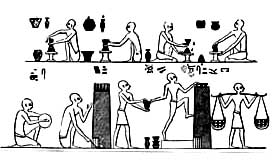
Egyptian Making Pottery, With Furnace Beni Hasan, 1900 B.C.
The given analyses do not differ from those of some soda-lime glasses of modern times. Lead was used in glasses from very ancient times. French scientist analyzed a vase of the Fourth dynasty in Egypt that contained about one quarter lead.
Artificial pearls, made of glass, were manufactured in such numbers that they formed an important article of export trade, and the old legends of enormous emeralds and other precious stones are most reasonably explained on the assumption that the preparation of paste jewelry was widely undertaken.
The earliest glass-works remains of which have been found date from the eighteenth dynasty, and the oldest dated glass object is a large ball bead bearing the cartouche of Amen-Hotep I, now in the Ashmolean Museum at Oxford. The invention of glass blowing, as opposed to the older method of glass-molding, is comparatively recent, dating back only to about the beginning of the Christian era. Sir Flinders Petrie has shown that the reliefs at Beni-Hassan, which were formerly supposed to represent glass blowers are more probably to be interpreted as metalworkers blowing a fire.

The beginning of the art s of weaving and dyeing are lost in antiquity. Mummy cloths of varying degrees of fitness, still evidencing the dyer1s skill, are preserved in many museums.
The invention of royal purple was perhaps as early as 1600 B.C. From the painted walls of tombs, temples and other structures that have been protected from exposure to weather, and from the decorated surfaces of pottery, chemical analysis often is able to give us knowledge of the materials used for such purposes.
Thus, the pigments from the tomb of Perneb (at estimated 2650 B.C.), which was presented to Metropolitan Museum of New York City in 1913, were examined by Maximilian Toch. He found that the red pigment proved to be iron oxide, hematite; a yellow consisted of clay containing iron or yellow ochre; a blue color was a finely powdered glass; and a pale blue was a copper carbonate, probably azurite; green were malachite; black was charcoal or boneblack; gray, a limestone mixed with charcoal; and a quantity of pigment remaining in a paint pot used in the decoration, contained a mixture of hematite with limestone and clay.
So many analyses results made by known scientists all serve to illustrate the character of the evidence furnished by chemical analysis of surviving samples of the products of early chemical industries.

Egypt is generally recognized as the mother of the chemical and alchemical arts, but unfortunately her monuments and literature have left little of the early records that explain these arts.
Some of these ideas have been transmitted to us through Greek and Roman sources but the character of these sources do not enable us to discriminate between the matter derived from Egypt and the confused interpretation or additions of the early Greek alchemists.
Much of this has to do with the Hermetic teachings passed down through the ages as part of the mystery school teachings.
Somewhere around 290 A.D. the Emperor Diocletian passed a decree compelling the destruction of the works upon alchemical arts and on gold and silver throughout the empire, so that it should not be the makers of gold and silver to amass riches which might enable them to organize revolts against the empire. This decree resulted in the disappearance of a mass of literature that doubtless would have furnished us with much of interest in the early history of chemical arts and ideas.
There have been saved to our times two important Egyptian works on chemical processes; the earliest original sources on such subjects discovered at Thebes (South Egypt), and both formed part of a collection of Egyptian papyrus manuscripts written in Greek and collected in the early years of the nineteenth by Johann d¹Anastasy vice consul of Sweden at Alexandria. The main part of this collection was sold in 1828 by the collector to the Netherlands government and was deposited in the University of Leyden. In 1885, C. Leemans completed the publication of a critical edition of the texts with Latin translation of a number of these manuscripts, and among these was one of the two works above mentioned.
It is known as the Leydon Papyrus.
The French chemist Marcelin Berthelot who was interested in the history of early chemistry, subjected this Papyrus to critical analysis and published a translation of his results into French with extensive notes and commentaries.
On the basis of philological and paleography evidence, he concluded its date is about the end of the third century A. D. It is, however, manifestly a copy of a work previously written, as slight errors evidently due to a copyist, are found. That the original is later than the first century A. D. is certain, as there are included in it extracts from the Materia Medica of Dioscorides. The work is a collection of chemical recipes and directions for:
1. Making metallic alloys
2. Imitations of gold, silver or electrum
3. Dyeing and other related arts
The Leyden papyrus comprises about seventy-five recipes pertaining to the making of alloys, for soldering metals, for coloring the surfaces of metals, for testing the quality of or purity of metals, or for imitating the precious metals.
There are fifteen recipes for writing in gold or silver or in imitation of gold and silver writing. There are eleven recipes for dyeing stuffs in purple or other colors. The last eleven paragraphs are extracts from the Materia Medica of Dioscorides, relating to the minerals or materials used in the processes involved.
One interesting fact is a test for pure gold. Test for purity of gold, remelt and heat it. If pure, it keeps its color after heating, and remains like a coin. If it becomes whiter, it contains silver, if it becomes rough and hard, it contains copper and tin, if it softens and blackens it contains lead.
To write in letters of gold - take quicksilver, pour it into a suitable vase and add gold leaf. When the gold appears dissolved in the quicksilver, shake well, add a little gum, one grain for example, and letting it stand, write in letters of gold.
Manufacture of asem (electrum):
Tin, 12 drachmas; quicksilver, 4 drachmas; earth of Chios, 2 drachmas. To the melted tin add the powdered earth, then add the mercury, stir with an iron, and put it into use.

When Alexander the Great conquered Egypt in 33 B.C. and his general Ptolemy became King of Egypt, the Greek city of Alexandria was founded, and soon became not only the most important city of Egypt, but through the foundation of schools and the accumulation of libraries became the acknowledged center of the intellectual world.
As the power of Rome grew, Greek and Egyptian power declined. Egypt became a Roman province in 80 B. C. A fire, started, it is recorded, from ships burning in the harbor during Caesar's conquest of Alexandria, burned an important part of the collection of manuscripts of the Alexandria libraries.
Under the Roman Empire, Alexandria, however, still exerted great influence and in the reign of Augustus was a metropolis second only to Rome itself, but in the succeeding centuries when Rome was suffering from internal disintegration and the Roman Empire was crumbling from successful barbarian invasions; Alexandrian culture also yielded to the general demoralization.
In the third century, the conditions throughout the Empire were such as to justify the statement of competent critic - "In the tempest of anarchy during the third century A.D. the civilization of the ancient world suffered final collapse. The supremacy of mind and of scientific knowledge won by the Greeks in the third century B.C. yielded to the reign of ignorance and superstition in these social disasters of the third century A.D."
In the light of present knowledge, it was in the period of the first to the third centuries that the mystical cult which cultivated the fantastic ideas of that kind of chemical philosophy which later came to be called alchemy, first developed. The beginning seems to have been the development of a secret cult of Alexandrian mystics bound by oath never to reveal to the uninitiated the mysterious knowledge which they claimed to have. That the members of the cult were originally of the Egyptian priesthood or foreign scholars initiated by them, seems probable, for Egyptian deities or mythological personages are prominent as authorities in their writings.
That the cult was of comparatively late development is evidenced by the prominence of Persian, and Hebrew authorities that were also frequently cited in their early writings. All this points to the cosmopolitan influence of the Alexandrian schools the melting pots of Greek, Egyptian, Hebrew, Persian and Chaldean philosophies, sciences, religions and superstitions. The universal sway of the Roman power and the pax Romana had also the effect of spreading the various cultures and national religions, but at the same time of weakening their authority.
In the early centuries of our era, Rome and Athens contained temples of Egyptian Isis, and shrines to Mithra, the Persian sun god, were frequent in Greek and Roman cities, symptoms of a decline in the power of the ancient religions in the centers of civilization under the Empire.
There was rising the new and at first persecuted sect of Christians destined soon to supplant the old faiths. Recognized and protected early in the fourth century under the Emperor Constantine, the new sect as it gained influence waged war upon the schools of ancient pagan philosophies.
In 389 A.D. the Serapion of Alexandria was destroyed, and its library destroyed or scattered under an edict of Theodosius calling for the destruction of all paean temples within the Empire, an order executed with much severity and cruelty. In the same year, Zeno, Emperor of the East, closed the important school at Edessa and its Nestorian teachers were banished, finding refuse in Asia. The Museum of Alexandria, a real university, still maintained a precarious existence until 415 when in riots incited by the Christians, the last remnants of Alexandrian schools of philosophy and science were swept away and the last notable teacher and philosopher of that school, Hypatia (370 - 415) fell a victim to the violence of the mob.
When the Muslim State ruled Asia Minor, the Syrian scholars were patronized by the Caliphs, were employed in influential positions as physicians, astronomers, mathematicians, engineers, etc., and the Syrian manuscripts of Greek and Alexandrian authors were translated into Arabian. The early Muslim culture was more hospitable to these ancient sciences and philosophies than the early Christian, and thus Arabians became in medieval times the best trained scholars in mathematics astronomy, medicine and chemistry.
As the wave of Muslim culture in the seventh and eighth centuries swept over Egypt and Morocco to Spain, Spain became the seat of a high degree of Muslim culture which endured until the final expulsion of the Moors in 1492 put an end to the Muslim rule in Western Europe. From Spain, however, the classical culture preserved by Syrian scholars and by them transmitted to Arab scholars, found its way to Europe, and Arabian mathematicians, physicians, alchemists, were held in high esteem as scientific experts.
Arabian translations, elaborations and commentaries from ancient Greek and Greek-Egyptian authors received from Syrian versions and finally translated into Latin in the twelfth and thirteenth centuries, became the great authorities in natural science. So completely had the original Greek writings disappeared from sight in the middle ages of Europe that later centuries quite generally assumed that the Arabians were originators of very much that they had acquired and transmitted from original Greek and Alexandrian writers through Syrian and Arabic translations.
Particularly was that true in the field of chemical knowledge, though modern research has made it clearer that the additions in that domain to the knowledge possessed by Alexandrian writers of the third and fourth centuries are of very subordinate significance. In the history of chemical science in Europe, Arabian influence is of importance because it was through this channel that interest in the science was again introduced to Latinized Europe.
At about the beginning of our era, it was in Alexandria, so far as we can ascertain, that that phase of chemical activity and speculation that we call alchemy originated. The earliest alchemical writers whose writings have been in part at least preserved to us were manifestly Alexandrian Greek-Egyptians.
They wrote in Greek and their writings contain allusions and traditions connecting with the ancient Greek philosophy of nature, with Plato and Aristotle, but also allusions and ideas related to Persian and Egyptian culture. In so far as these writings contain references to the devices and methods of experimental chemistry, these earl alchemists allude to just such practical operations as we have seen in the Egyptian papyri from Thebes, although they are rarely so definite and clear as the latter descriptions and directions, and are mingled with a confused mass of obscure allegorical narratives and descriptions. These find their analogies in the fantastic notions of the later Alexandrian neo platonic philosophers and related mystical cults belonging to the transition period of the fall of the Egyptian and Greek culture and the rise of the Christian philosophy with its mixture of traditions and ideas from many different ancient cults and religions.
Internal and external evidence are to the effect that the phase of chemical activity and interest which so long held the stage not only in Europe but also in Arabia and Asia, spreading even to India and China, had its origin in the practices of the metal workers of Egypt and in the theories of matter and its possible changes as developed in the neo platonic school of natural philosophy. In so far as the neo platonic philosophy as applied to alchemy possessed a basis in ancient Greek philosophy, it was based mainly upon Plato's conceptions as formulated in his work entitled "Timaeus."
This metaphysical physical science of Plato, imaginative and fantastic in itself, became even less logical and more fantastic by the elaborations and interpretations of the later neo Platonists who "based their philosophy on revelations of Deity and they found those in the religious traditions and rites of all nations."
As the Timaeus of Plato appears to have furnished the more fundamental concepts which dominated the ideas of matter and its changes to the early and later alchemists, it will be of help in understanding some of these ideas if this work is explained in some detail.
In the form of dialogue, though substantially a monologue, Timaeus is represented as explaining to Socrates his formulation of the generation and development of the physical universe.
Ancient Egyptian practiced various forms of medicine. The 'Smith Papyrus', and to a lesser extent the 'Ebers Papyrus', give us a very favorable idea of the medicine, anatomy, and physiology of the Egyptians
The earliest physician whose name has been recorded, Imhotep," was the wazir of Zoser, founder of the Third Dynasty, in the thirtieth century. Imhotep was a learned man, astronomer, physician, architect (he may have been the builder of the first pyramid, the step pyramid of Saqqara). In later times he was worshiped as a hero, as a blameless physician, and later still as the god of medicine, the prototype of Asclepioseven as the God Thoth was the prototype of Hermes and Mercury. We know precious little about Imhotep's medical knowledge but his apotheosis is significant and we may well take him at the Egyptian valuation as the first great man in medicine.
Not only were there many physicians in the Pyramid Age, but there were very specialized ones. The skill of an early dentist is beautifully illustrated by a mandible found in a tomb of the Fourth Dynasty, in which an alveolar process was pierced to drain an abscess under the first molar. From the tombstone of Iry, chief physician to a pharaoh of the Sixth Dynasty (2625-2475), we learn that he was also "palace eye physician" and "palace stomach bowel physician" and bore the titles "one understanding the internal fluids" and "guardian of the anus."
The medical papyri that have come to us, seven or more, are relatively late. They date from the Twelfth Dynasty to the Twentieth (2000 to 1090), but most of them reflect professedly earlier knowledge, going back to the Old Kingdom, as far back as the Fourth Dynasty. The two earliest papyri, the Kahun and the Gardiner fragments (c. 2000), deal with diseases of women, children, and cattle. The two Most important ones, the so-called Smith and Ebers papyri, date from the seventeenth and sixteenth centuries B.C.
The Smith one is of the same age as the Rhind mathematical papyrus. Roughly speaking, we may say that the outstanding, mathematical and medical treatises that have come to us are of the same period, the the Middle Kingdom and the beginning of the NewKingdom just prior the imperial age, when Egypt dominated the world.
Let us consider more carefully the two outstanding, the Smith and the Ebers, both of which are much larger than any others. On the basis of the figure given by Sarton, the seven medical papyri listed by him include 3746 lines, the Smith has 469 lines and the Ebers 2289, so that together they have 2758 lines, which is almost 74 percent of the total.
As all the manuscripts are ultimately derived from similar Old Kingdom sources, we may safely assume that the study of the Ebers and the Smith papyri will give us a fair knowledge of ancient Egyptian medicine. We shall begin with the younger one, the Ebers papyrus, because it is by far the largest (almost five times as large as the Smith) and was the best known until very recent times. The difference in age is small anyhow, about a century, and negligible if one bears in mind that both texts represent older traditions.
The Ebers Papyrus
It appears that the Ebers papyrus was written somewhat later than the Smith papyrus, but this has not as yet been conclusively proven. It was said to have been found between the legs of a mummy in the Assassif district of the Theben necropolis.
The Ebers papyrus is a roll 20.23 m long and 30 cm high; the text is distributed in 108 columns of 20 to 22 lines each. It contains 877 recipes concerning a great variety of diseases or symptoms. Spells are recommended only in twelve cases and in other cases the therapeutics does not seem irrational, though we are seldom able to understand either the trouble or the remedy.
The Ebers Papyrus comprises 110 pages, and is by far the most lengthy of the medical papyri. It is dated by a passage on the verso to the 9th year of the reign of Amenhotep I (c. 1534 B.C.E.), a date which is close to the extant copy of the Edwin Smith Papyrus. However, one portion of the papyrus suggests a much earlier origin.
Paragraph 856a states that : "the book of driving wekhedu from all the limbs of a man was found in writings under the two feet of Anubis in Letopolis and was brought to the majesty of the king of Upper and Lower Egypt Den." The reference to the Lower Egyptian Den is a historic anachronism which suggesting an origin closer to the First Dynasty (c. 3000 B.C.E.)
The Ebers Papyrus consists of a collection of a myriad of different medical texts in a rather haphazard order, a fact which explains the presence of the above mentioned excerpt. The structure of the papyrus is organized by paragraph, each of which are arranged into blocks addressing specific medical ailments.
The Edwin Smith Surgical Papyrus is, without a doubt, one if the most important documents pertaining to medicine in the ancient Nile Valley.
The Edwin Smith papyrus is second in length only to the Ebers papyrus, comprising seventeen pages (377 lines) on the recto and five pages (92 lines) on the verso. Both the recto and the verso are written with the same hand in a style of Middle Egyptian dating. It is 33 cm high and was probably 5 m long, but the beginning has been lost and it now measures 4.70 m. lt is a copy of a much older text, dating back to the Pyramid Age, perhaps even early in that age, let us say the thirtieth century. After it had circulated for some generations it was found that its terms were antiquated.
Toward the end of the Old Kingdom, say in the twenty-sixth century, a learned physician had the idea of rejuvenating it by the addition of glosses (69 in all), explaining obsolete terms and discussing dubious matters. (N.B. the Papyrus Ebers has also some glosses, 26 in all, but they have been badly messed up). These glosses constitute the most valuable part of the papyrus. The text as we have it now comprises two very distinct parts17 columns (377 lines) on the front and 4.5 columns (92 lines) on the back. The latter part contains only recipes and incantations and need not detain us. The main part is a surgical treatise, informed by a scientific spirit far superior to that of the Ebers papyrus.
To be sure, the field of surgery is much less likely than that of internal medicine to be contaminated by irrational ideas, for in most surgical cases dealt with by ancient physicians the cause of the injury was too obvious to require the insertion of magical antecedents. On the contrary, an internal disease is always mysterious and likely to breed superstitious ideas in the patient's mind, even in the physician's mind.
The Smith papyrus consists not of recipes but of definite cases. It was planned to deal with the ailments in the order of the bodily parts from head to foot, but unfortunately it stops a little below the shoulders, whether because the scribe was interrupted or because the end of the manuscript got 1ost. That ordereis podas ec cephales, a capite ad calces -remained the one throughout the Middle Ages, but it was so natural, as a first approximation, that we should not assume it was determined by the Egyptian example.
The forty-eight cases dealt with in the papyrus, as it has come to us, are classified as follows:
The discussion begins with the head and skull, proceeding thence downward by way of the nose, face and ears, to the neck, clavicle, humerus, thorax, shoulders and spinal column, where the text is discontinued, leaving the document incomplete. Without any external indication of the arrangement of the text, the content of the treatise is nevertheless carefully disposed in groups of cases, each group being concerned with a certain region.
There is no reason to believe that the ancient Egyptians had studied anatomy, by means of deliberate dissections, but they had taken advantage of the accidental experiments falling under their eyes and had accumulated much knowledge. Of course, the mummification of dead bodies of men and animals, which had been practiced from time immemorial, might have taught them many things, but I am rather skeptical about that; the embalmers were too much concerned about their own difficult art to pay attention to irrelevant anatomic details. lt is possible that the practice of mummification made it easier later, much later, in Ptolemaic times, for Greek scientists to undertake systematic dissections, but that is another story. As far as ancient Egypt is concerned there is no evidence of the influence of mummification on anatomic knowledge.
The author whose work is recorded in the Smith papyrus had meditated on anatomic and physiologic questions. He was aware of the importance of the pulse, and of a connection between pulse and heart. He had some vague idea of a cardiac system, though not of course of a circulation, which nobody clearly understood before Harvey (and before him the Muslim physiacin Ibn Al-Nafis). His knowledge of the vascular system was made hopelessly difficult by his inability to distinguish between blood vessels, tendons, and nerves.

Ancient Egyptian Alchemy

Al=God Khem=Egypt
Ancient Egyptians were into all kinds of magic and astrology. They considered alchemy a science, perhaps the science of immortality eternal life. Alchemy as a transition metalboth physical and metaphysical would take many turns in the millennia that would follow. Transition metalsturning base metals into goldand alchemy of consciousness moving from physical reality to that of higher frequency.
The roots of alchemy date back to an ancient Egypt document called The Emerald Tablet of Thoth. In Greece Thoth was called Hermes the MagicianHermes Trismegistus which is thought to be the foundation of alchemy. Thoth stated, 'As is Above, So is Below', the duality of our experience in third dimension.
Thoth was considered part of the Zep Tepi the creation gods who came here as a Giant or Godand lived befre recorded hostory and the pyramids. The famous Emerald Tablet (Tabula Smaragdina) of Hermes is the primary document of alchemy. There have been various stories of the origin of the tract, one being that the original emerald slab upon which the precepts were said to be inscribed in Phoenician characters was discovered in the tomb of Hermes by Alexander the Great.
Alchemy in ancient Egypt was about Magic, Magicians, Priests. Thoth and Hermes who was Merlin and later Zoroaster [Magi] the magicianswho created a reality based on electromagnetic energiesdualitypolarity magnetsmagic mathematical patterns that repeat in the spiraling concept of time.
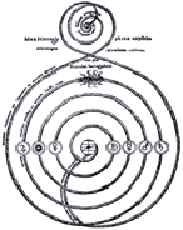
Egyptian Heiroglyph
Following Sacred Geometry
You spiral down and around slowly -
Hit Zero Point
In alchemy we separate the gold from the slag. The metal is placed in a crucible where it is heated with fire. Fire are the experiences of the Earth planethe emotional body. One has only to transmute the fireto move into conscious awarenes where creation begins and ends and all answers reside beyond the alchemy of time and space.




0 comments:
Post a Comment